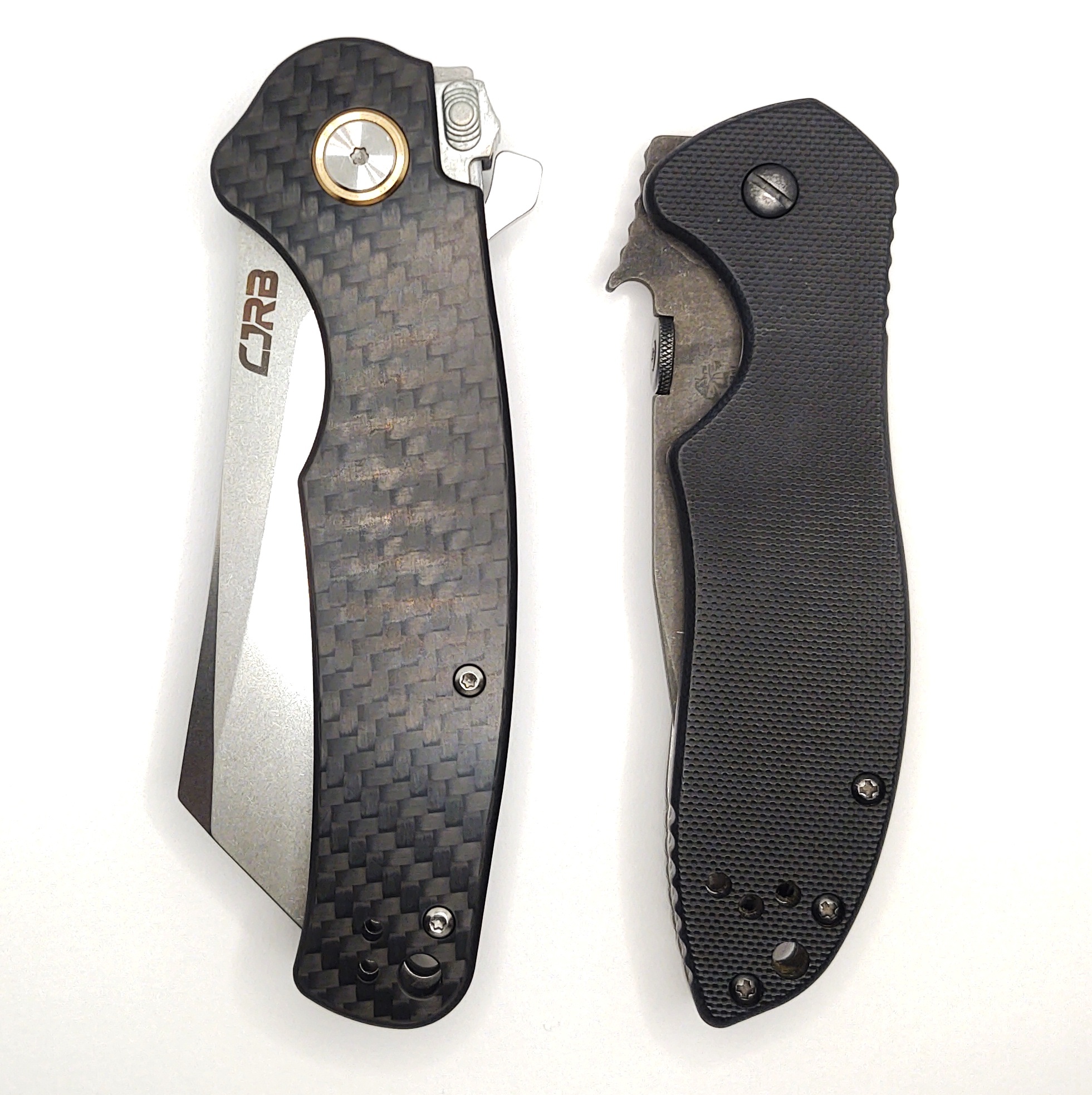Numerous Knife Disorder New Knife Day it is once more.

This here’s the CJRB Crag.
Just how the hell you’re supposed to pronounce CJRB is not the only unknown to me. I’d never heard of this brand until recently, and apparently it’s a cheaper sub-brand of Artisan Cutlery that’s been around since 2019. They have a web site, which unfortunately stops short of specifying how you’re supposed to say it or even what the heck “CJRB” stands for. It does, however, go on to specify that CJRB knives carry a 14 day “no DOA guarantee.” That just raises further questions.

Anyhow. The Crag.
This is a stonking huge ball bearing flipper opener with a blade made of Artisan/CJRB’s proprietary AR-RPM9 steel. It’s also available in D2, and I do like a good D2 knife to the point that I have at least ten of them. But for once I figured I’d give something different a shot, so here we are with the weird proprietary steel.
Artisan has this to say about their steel, which is full of the usual fluff you’d expect along the lines of their steel being so great, not to mention corrosion resistant, hard wearing, tough, and easily sharpenable – as if several of those properties aren’t mutually exclusive. Every manufacturer says this about their steel, and why wouldn’t they? Nobody’s going to make any sales by blathering about what specific things their steel sucks at. You can get a little more objective information on it from ZKnives, which indicates that it probably won’t hold an edge as well as D2 (darn), but ought to be mechanically superior to the likes of 8cr and the 440 series. It’s sure to be more rust resistant than D2, also, rust being something that’s a perpetual thorn in my side on all my D2 knives. So that’s nice.

The Crag has this big cleaverlike reverse tanto point. Suddenly all the cool kids seem to have this kind of blade profile nowadays, although search me why the sudden interest. Back in my day we just called this thing a Wharncliffe blade and didn’t make such a big deal about it. I selected the version with the groovy carbon fiber handle scales. Other variants are available. This one has a finish on the blade described as “satin,” which appears to be a tumbled stonewashy kind of process over the bare steel. The surface finish is very nice overall, especially for something billed as a budget knife, and does not sport any of the exposed machining marks we’ve gotten sick of looking at recently. The bevel is a hollow grind, although the top near the spine is left square.
The Crag is 8" long open, 4-5/8" closed, with a 3-3/8" blade in that reverse tanto shape. The blade is 0.127" thick at the spine, so a tad beefier than most. Despite this the Crag is not excessively large in terms of overall or blade length, but it’s quite broad: The blade is over an inch and one quarter wide, 1.274" to be precise, at its widest point. The entire edge has a subtle upsweep to it that presents a highly usable “all belly” edge. There is a very generously sized combination choil and finger notch at the base of the blade, but it’s forward of the kicker (which along with a cutout in the handle forms yet another finger notch) so you have to be super choked up on the blade to use it for anything.
It’s similarly broad when closed as well, with the widest point actually being at the transitional angle between the main blade and the reverse tanto point on the spine of the blade, and it 1-9/16" at this location. That’s huge. If you have skinny hipster jeans, this knife probably isn’t going to work for you.

It’s 0.510" thick not including the clip, near as makes no difference to half an inch. The clip is a deep carry design and is reversible via a pair of screws that go directly into the steel liners. With the clip it’s 0.808" thick in total, including the swanky brass-embellished pivot screw heads that sit proud of the surface (by 0.058", if you must know). It’s 132.5 grams (4.67 ounces) in heft, an unknown portion of that contributed to by the carbon fiber scales. The variants with other materials may weigh more, I don’t know. You all are going to have to give me a raise if you want me to buy them all and compare.

The Crag is a flipper opener through-and-through and does not have thumb studs. The only way you can open it is by kicking the flipper on the rear.

The pivot is riding on ceramic ball bearings, and the opening action is buttery smooth. Exemplary. Nearly flawless. I love it.
Oh yeah, and it also purports to have a funny lock. We all know that kind of thing is my jam.
There’s a liner locking version of this knife under the same name, too, but that’s for boring wimps who don’t get invited to parties. CJRB calls this their “Recoil-lock,” but they don’t mention anything more about it. In fact, the product blurb for their Recoil version still mentions having a liner lock, which this knife very definitely doesn’t.

Instead there’s this sliding toggle thing on the spine of the knife. It’s jimped sightly on its top surface, and also has some stairsteppy grip surfaces machined into the sides. It’s hard to notice in operation but it actuates aft and then back to the fore when you kick the knife open, and when you pull it rearward in its little track the blade flops around freely. (Editing note: “Machined” is the wrong word to use here. The lock trolley is clearly cast, and all of its grip ridges are part of the casting. The inner surfaces are machined to be flat, however, and the pin holes in it are surely drilled as part of some final process to ensure that they actually have sufficient precision.)
Well, there’s a humdinger. A lock that toggles with the blade action and completely disengages when held back. That sounds awfully familiar.

Yep. There’s an Axis lock hidden in there. But rather than expose it with the traditional two buttons sticking through either side, CJRB has added a little trolley on top of it so it’s accessible from the spine.
That’s… actually slightly problematic if you’re not careful, because unlike the typical Axis design your natural inclination when operating this control layout is to slide the lock back with your thumb while the rest of your fingers are still wrapped around the handle, unlike the pinch operation you’d give a normal Axis knife. So if you do that, the blade can swing closed and it’ll bite you. Manipulating this takes a concerted mental readjustment if you’ve just switched from a different knife, I find.

And yes, you can Axis flick it both open and closed. When closing, the blade is so heavy and the pivot so effortless than you can actually allow it to just fall shut. Hold it upside down and you can, with a modicum of practice, get it to fall open as well. Jury’s out of this makes it count legally as a “gravity knife.” If I were you, maybe I wouldn’t show off that aspect of it to any policemen.
If you hold the lock back and swing the blade out to open it the knife literally rings like a bell when the blade hits the end stop pin. Here’s an MPEG of it, with sound.
It’s glorious. I could do that all day.

The Crag was very easy to disassemble, in that all the screws came out cleanly and without fuss, all the hardware fits together impeccably, and overall it just feels like an enthusiast’s knife in general mechanical fitment.
There are hidden dangers lurking inside, though, specifically that the Crag is absolutely brimming with tiny parts that’ll fall out of it and get lost if you’re not careful.
The major offenders are these tiny pins that are what hold the lock trolley into its track:

Those are the ones all the way on the left. There are four of them in total, two per side, although only two are shown in this photo. The other two are safely… elsewhere. They’re tiny. Like, 2mm long. Maybe not even that. They’re also not held in by anything so they will fall out when you remove either handle scale and you’d better be ready for it or you’re going to be grovelling around on the carpet.
Also visible there is the crossbar from the lock, and the end stop pin for the blade’s travel to its open position. Or, if you prefer, the part that makes it go “ding.”

Here are the bearings. They’re ceramic, in nylon carriers.

The brass garnishes around the pivot screws are separate pieces. I believe this is also a contender for knife with the widest pivot screw head. Look at that thing – it’s a goddamn Frisbee.

There are no surprises to be found on the edge, neither good nor bad. Mine came sharp enough out of the box to easily cleave a Post-It in two without much effort. If CJRB’s hype is anything to be believed, it ought to be a doddle to make it even sharper.

The edge on mine was just ever so slightly out of true from the factory. That’s a touch disappointing, but not unexpected given the $40 or so price point. Reprofiling this on your Ruxin or whatever ought to be easy; there are no thumb studs to get in the way, and the spine of the blade has a usable flat section on it that ought to help keep everything in alignment in your jig.

Compared to the usual CQC-6K, the Crag is longer, wider, thicker, and considerably more swanky.
The Inevitable Conclusion
Ask not for whom the knife dings. It dings for thee.
Do everyone a favor and keep writing these reviews forever.
I’m not necessarily into knives, but I stumbled on this post, and its by far the most detailed, in depth, while also being entertaining to read knife review I’ve seen. Makes me want one
So yes, please keep writing reviews OP.
Wonderful review, thanks!
I’m a big fan of CJRB. Their knives hit a very nice price point and the QC on mine have been really good. I have a few (5? 6? I donno, don’t ask me to count knives) of theirs and all have punched above their price point. I’ve had no issues with edge retention with their RPM9 steel but I’ve not done any systematic tests against D2. It certainly sharpens up nicely. They’ve had a bit of a runaway hit with their Pyrite and Pyrite-Alt models in the past year and half or so.




